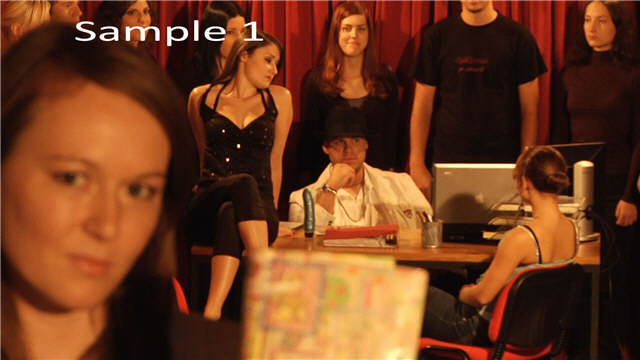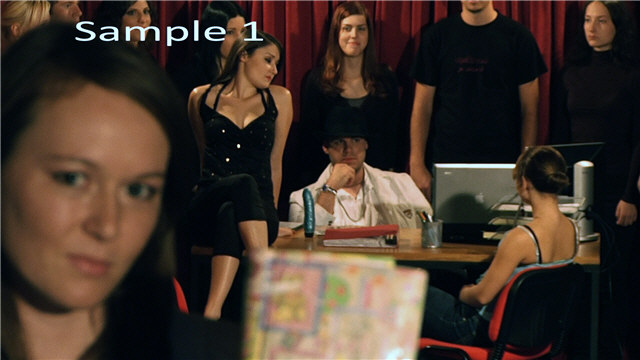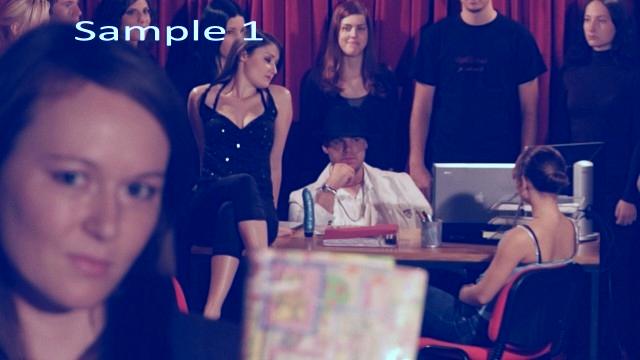Hello.
I have a problem with white-balance. I've made a mistake at shooting, because I didn't manually set white balance.
I am wondering if there is an easy way - to somehow analyse one clip/frame and then the other, and then just set some parameters. Is it possible to do it in A. Premier or AE?
I'm attaching an image of two frames - Sample 1 is the one with wrong white balance..., sample 2 is the one with right. Is it possible to somehow tell that to an editing program?
color-problem.jpg
+ Reply to Thread
Results 1 to 21 of 21
-
-
If you are using DV as your source then you can correct white balance with our DV processor in real-time with no recompression needed.
http://www.enosoft.net/products/enodvproc/How-To/WhiteBalance/HowToWhiteBalance.htmJohn Miller -
Yes you can color correct in programs such as AE, Premiere, Vegas. There are color match filters , but you usually need to manually fine tune adjustments for shadows/midtones/highlights and levels adjustments in each of the red/blue/green channels. So it's not as easy as push a button and presto it works...it takes a bit of fiddling
I adjusted levels in red, green blue in after effects here. There's lots of room for improvement (eg. the blacks and shadows don't quite match between the corrected #1 and #2), but I just wanted to quickly demonstrate it's possible to improve on the color cast.
Color adjustments should be done before things like titles and other effects (notice the overlay letters have a blue discoloration now), unless you mask them out or apply corrections to masks
Before #1

After #1

#2

-
Ok - I see, you're really good at it... I'm trynig my best on it for almost two days now, and I did't come even close to your "quick" solution
 ... could you help me some more...please
... could you help me some more...please  !
!
-
No, I'm not very good at it. I'm still learning stuff too. You can definitely improve it if you spend more time
I just played with the levels filter, and the key here is to adjust individual R,G,B channels in the levels filter. Many people forget that you can do that with the levels filter, and use "RGB" mode for the levels filter only. You could use "levels (individual channels) filter", but it's the same thing.
The general approach is to start with the red channel (because that's the worst in your example). Then I just played with the gamma and output sliders, and did that for each channel
Here is the ffx animation preset with the settings I used, to get you started
untitled.ffx -
You need to be aware that adjusting R,G and B is not necessarily correct. It depends on how the original camera applied the white balance. For many cams, white balancing is achieved by changing the chroma and not RGB. Compensating for incorrect balance should be done on the color part of the signal only and not the black and white. Adjusting R, G and B affects both. The more appropriate method is to add an offset to the chroma channels (Cr/Cb). But you need software that can operate in the YCrCb space and, preferably, has a vectorscope.
With RGB-only software you are forced to apply RGB gain adjustments at multiple brightness levels. This is very tedious and not very robust. -
JohnnyMalaria - Could you do it with avisynth and coloryuv ? e.g. off_u and off_v ? If you used the original footage you would stay in the same colorspace
EDIT: I played with coloryuv, but the gamma_u and gamma_v are non-functional
What other software alternatives could you use to adjust without converting to RGB colorspace ? -
I'm sure JohnnyMalaria is right (because he's very smart), but I find it really tricky to adjust u and v to get what I want, whereas I find the changes to RGB quite intuitive. Also, I suspect cameras adjust the white balance by playing with the RGB values from the sensor before they're encoded to YUV.
For u and v adjustment in AVIsynth, I've tried things like this...
...which let you do anything to u and v which you can do to y.Code:u=utoy() v=vtoy() u=u.Levels(16,1.0,230,0,255,coring=false) v=v.Levels(10,1.0,255,0,255,coring=false) ytouv(u,v,last)
Yet I find messing around with RGB gives the result I want much more easily. Not sure how to do this easily in AVIsynth though - RGBadjust does it, but it's not as nice to use as the levels control in a photoshop program.
Cheers,
David. -
The U and V values are centered around 128. That is, to get a grayscale image (eliminate color) you set U and V to 128, not 0. To increase saturation you push U and V away from 128. That is, values below 128 are decreased, values above 128 are increased. To decrease saturation you push values toward 128. Mathematically that's:Originally Posted by poisondeathray
C' = (C-128) * saturation + 128
where C = U,V. So gamma doesn't really make sense to U and V. I think this is why the gamma_u and gamma_v don't do anything in ColorYUV(). -
Yes - that would be the simplest way (I assume the off_u and off_y functions relate to offsets).Originally Posted by poisondeathray
As 2BDecided hints, it does come down to how the camera did the white balance in the first place. I stumbled across fiddling with U and V offsets quite by accident while testing my software's white balance setting display bit. I happened to be running the vectorscope at the same time. As I deliberately changed the camera's white balance and monitored the feed I noticed that the information on the vectorscope simple shifted from one location to another - i.e., the camera was just applying offsets to U and V. The difficulty with the RGB approach is that just changing one of the components will also affect the luma. Removing things such as color casts, adjusting white balance etc need to be done on the chroma only.
I can't provide specific info re Avisynth but if you can isolate a part of a frame where you know something should be neutral (any grey shade) and look at the average U and V values then these become the values to subtract from the entire frame. This is where a vectorscope and a couple of sliders are really helpful!John Miller -
My guess is that most cameras do their color balance in RGB because the CCDs are RGB. The functions may not be linear though.Originally Posted by JohnnyMalaria
That doesn't work -- at least with the OPs sample image. Concentrating on the man's shirt (assuming it is supposed to be white) I used the following script to make the shirt white simply by adjusting off_u and off_v:Originally Posted by JohnnyMalaria
The resulting image has a white shirt but there is a huge blue tinge to the darker areas:Code:ImageSource("p1.jpg", start=0, end=23, fps=23.976) ConvertToYV12() ColorYUV(off_u=43, off_v=-29)

-
jagabo - What about CMOS type cameras? are their color balancing done in RGB?
Would color correcting on this RGB jpg image make any difference vs. color correcting on the YV12 original video? (When using the coloryuv in avisynth, we convert the image back to YUV, so is it possible there were some rounding errors?) or would that not be big enough to explain what we are seeing here?
I'd actually prefer to learn how to do it properly in avisynth, in the same colorspace; but like 2BDecided, I find AE/photoshop style correcting much more easy - it might be that we are just more used to it. I played with his levels for u,v that he suggested briefly, but still can't get it looking right with that method -
I think most are also RGB. They both work by using colored filters over the sub-pixel light sensors. Some cameras use CMY to let more light through to the individual sensors:Originally Posted by poisondeathray
http://www.modernimaging.com/Kodak_DCS-620x_Technology.htm
Even with CMY I suspect the data is converted to RGB before filtering.
I don't think there's any more of a problem than the minor precision loss from the conversions -- at least in the IRE 0 to IRE 100 area. Consider if the original image was YUV and you performed ConvertToRGB() followed by ConvertToYUV() the differences would be nearly imperceptible.Originally Posted by poisondeathray -
As it turns out, it is really RGB and YUV. Most auto white balance algorithms assume that the overall image is neutral. i.e., if you add up the values of each of the R, G and B pixels in the image then they should be equal (since grey means R = G = B). If they are not equal then the gain of the R and, separately, B are adjusted such that they both equal G. i.e., R/G = B/G = 1. Now, the chroma components U and V are nothing more than the differences between R and G (R-G) and B and G (B-G). Relatively, the chroma components are (R-G)/G and (B-G)/G, i.e., R/G - 1 and B/G - 1. i.e., the same ratios as above. Hence, the white balance can be determined trivially in either RGB or YUV.
None of this is valid, however, if your subject was not light by the same color across the whole image. It assumes that, overall, the image is illuminated by a white source.
If this is valid and the method used is as above then the right way to fix the incorrect value is to adjust the R and B gains and leave G alone. A good starting point is to use the known white part of the image.John Miller -
But U isn't simply R-G, and V isn't simply B-G, the components are weighted.Originally Posted by JohnnyMalaria
http://fourcc.org/fccyvrgb.php
You may find it easy to adjust white balance in YUV but I don't!
That is usually what I do. If the image needs black level or contrast fixes I do that first, then I look for something that should be white and adjust R and B to match G. Green is the the largest contributor to luma.Originally Posted by JohnnyMalaria -
VirtualDub has some great color correction filters. I forget the name of the WB filter, but Colormill can tweak beyond what the WB one did.
Want my help? Ask here! (not via PM!)
FAQs: Best Blank Discs • Best TBCs • Best VCRs for capture • Restore VHS -
VirtualDub: White Balance by Jim Leanard. Gradation Curves by Alexander Nagiller is good for non-linear color adjustments.
-
I know. It was the general notion I was trying to put across. Anything in RGB space can be done in YUV. Many vectorscopes use "R-G" and "B-G" as the axes labels with good reason. White balancing by definition should only affect the color and not the luma. Hence, YUV-type color spaces are more appropriate. Using RGB is the norm because our typical image sensors are RGB. The RGB equations used are just alternative representations of YUV equivalents and vice versa. I can only report the findings of my tests with a variety of camcorders measuring pixel values via a vectorscope in response to white balance changes of a constant scene. Applying a simple offset works just fine. Different cameras may have more elaborate algorithms.Originally Posted by jagabo
Bottom line - use the tools you have and that give the results you want. Understanding mathematically what you are trying to reverse will help you choose the right of tools.John Miller -
CORRECTION: I should have used R-Y and B-Y (not R-G and B-G), not that it is of much consequence since G is pretty much the same as Y (as far as CIE tristimulus XYZ goes and Y being the same thing in XYZ and YUV). Rigorous calculation of color temp from RGB as vice versa requires transformation via XYZ which is a very close cousin of YUV (basically a different phase angle for the rotation in the UV or XZ planes).
-
I see what you're saying. Since RGB and YUV are linear transforms you could do equivalent color corrections in either. It's not clear to me that white balance is supposed to leave luma unchanged though.
Similar Threads
-
White balance sony pmw-ex1
By B-Twien Bytes in forum Newbie / General discussionsReplies: 0Last Post: 9th Mar 2011, 05:14 -
Please share your White Balance methods.
By thurnau in forum Newbie / General discussionsReplies: 10Last Post: 28th Nov 2010, 03:59 -
White Balance adjustment on PV-GS400
By Nouch 68 in forum Camcorders (DV/HDV/AVCHD/HD)Replies: 5Last Post: 28th Feb 2009, 18:41 -
Spotlight White Balance Washout
By jimcornetet in forum EditingReplies: 0Last Post: 31st Mar 2008, 19:25 -
Sony Digital 8 White balance.
By arcorob in forum Camcorders (DV/HDV/AVCHD/HD)Replies: 10Last Post: 9th Dec 2007, 17:48




 Quote
Quote